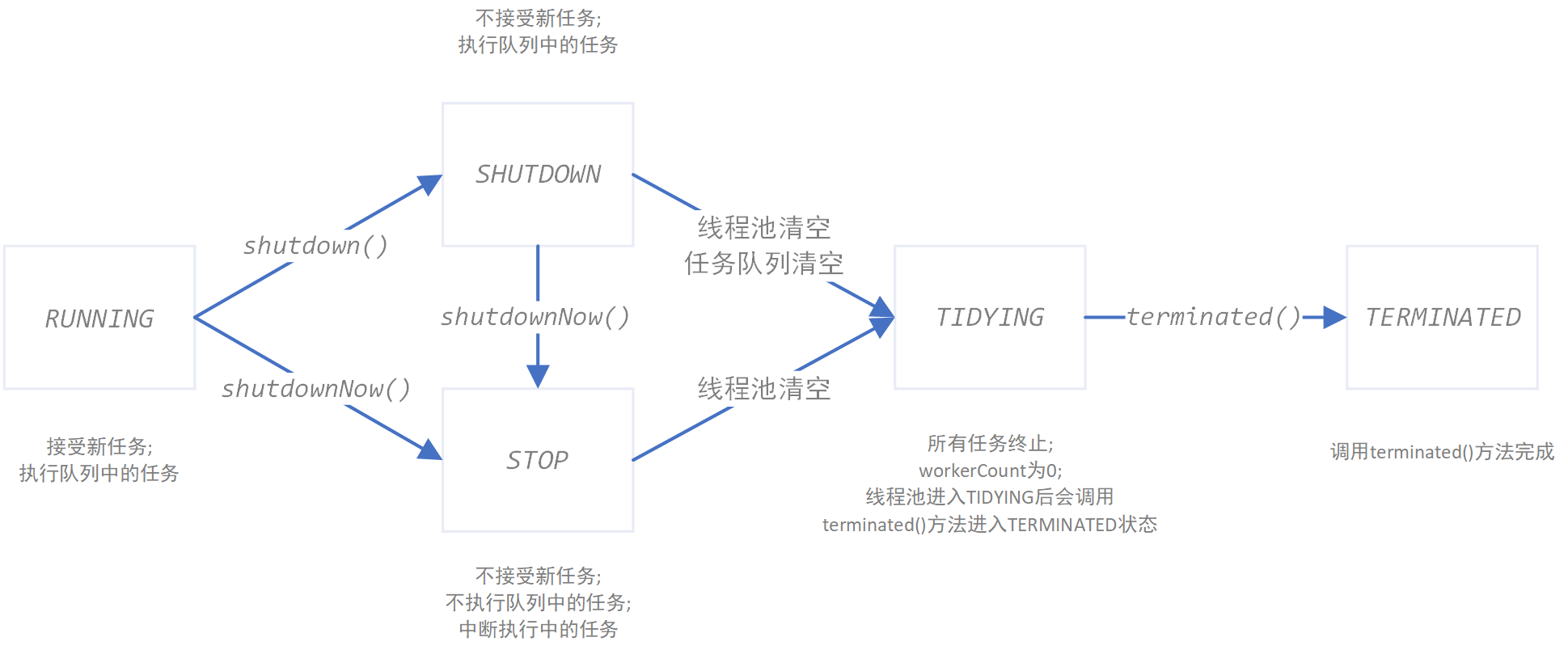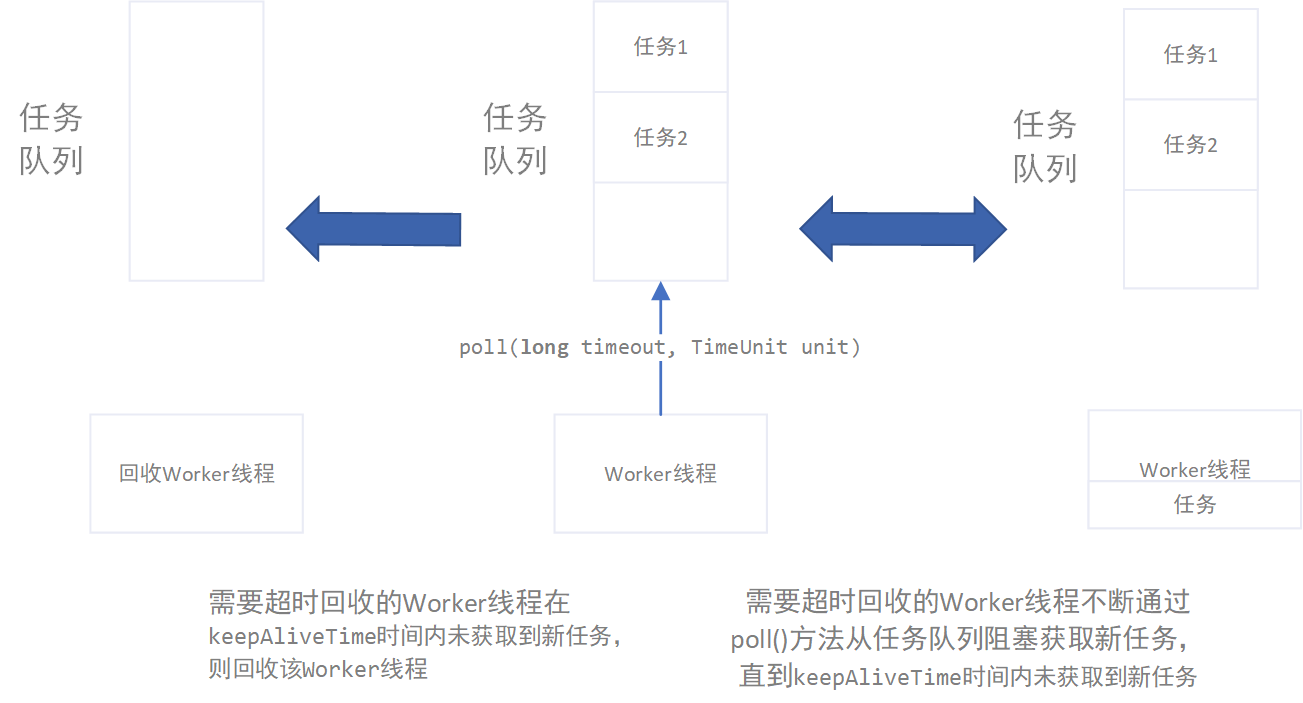线程池状态转换 java.util.concurrent.ThreadPoolExecutor为JDK的线程池对象,线程池的状态和状态转换如下图:
使用方式 1 2 3 4 5 6 ThreadPoolExecutor executor = new ThreadPoolExecutor(1 , 10 , 1 , TimeUnit.MINUTES, new ArrayBlockingQueue<>(10 )); executor.execute(new Runnable() { @Override public void run () } });
java.util.concurrent.Executors工具类下常用的快捷创建线程池的方法newCachedThreadPool()、newFixedThreadPool()、newSingleThreadExecutor实际上都是对ThreadPoolExecutor的封装。
1 2 3 4 5 6 public static ExecutorService newCachedThreadPool () return new ThreadPoolExecutor(0 , Integer.MAX_VALUE, 60L , TimeUnit.SECONDS, new SynchronousQueue<Runnable>()); }
1 2 3 4 5 public static ExecutorService newFixedThreadPool (int nThreads) return new ThreadPoolExecutor(nThreads, nThreads, 0L , TimeUnit.MILLISECONDS, new LinkedBlockingQueue<Runnable>()); }
1 2 3 4 5 6 public static ExecutorService newSingleThreadExecutor () return new FinalizableDelegatedExecutorService (new ThreadPoolExecutor(1 , 1 , 0L , TimeUnit.MILLISECONDS, new LinkedBlockingQueue<Runnable>())); }
状态源码常量 1 2 3 4 5 6 7 private final AtomicInteger ctl = new AtomicInteger(ctlOf(RUNNING, 0 )); private static final int RUNNING = -1 << COUNT_BITS; private static final int SHUTDOWN = 0 << COUNT_BITS; private static final int STOP = 1 << COUNT_BITS; private static final int TIDYING = 2 << COUNT_BITS; private static final int TERMINATED = 3 << COUNT_BITS;
源码解析
1 2 3 4 5 6 7 8 9 10 11 12 13 14 15 16 17 18 19 20 21 22 23 24 25 26 27 28 29 30 public void execute (Runnable command) if (command == null ) throw new NullPointerException(); int c = ctl.get(); if (workerCountOf(c) < corePoolSize) { if (addWorker(command, true )) return ; c = ctl.get(); } if (isRunning(c) && workQueue.offer(command)) { int recheck = ctl.get(); if (! isRunning(recheck) && remove(command)) reject(command); else if (workerCountOf(recheck) == 0 ) addWorker(null , false ); } else if (!addWorker(command, false )) reject(command); }
1 2 3 4 5 6 7 8 9 10 11 12 13 14 15 16 17 18 19 20 21 22 23 24 25 26 27 28 29 30 31 32 33 34 35 36 37 38 39 40 41 42 43 44 45 46 47 48 49 50 51 52 53 54 55 56 57 58 59 60 61 62 63 64 65 66 67 68 69 70 71 72 73 74 75 76 77 private boolean addWorker (Runnable firstTask, boolean core) retry: for (;;) { int c = ctl.get(); int rs = runStateOf(c); if (rs >= SHUTDOWN && ! (rs == SHUTDOWN && firstTask == null && ! workQueue.isEmpty())) return false ; for (;;) { int wc = workerCountOf(c); if (wc >= CAPACITY || wc >= (core ? corePoolSize : maximumPoolSize)) return false ; if (compareAndIncrementWorkerCount(c)) break retry; c = ctl.get(); if (runStateOf(c) != rs) continue retry; } } boolean workerStarted = false ; boolean workerAdded = false ; Worker w = null ; try { w = new Worker(firstTask); final Thread t = w.thread; if (t != null ) { final ReentrantLock mainLock = this .mainLock; mainLock.lock(); try { int rs = runStateOf(ctl.get()); if (rs < SHUTDOWN || (rs == SHUTDOWN && firstTask == null )) { if (t.isAlive()) throw new IllegalThreadStateException(); workers.add(w); int s = workers.size(); if (s > largestPoolSize) largestPoolSize = s; workerAdded = true ; } } finally { mainLock.unlock(); } if (workerAdded) { t.start(); workerStarted = true ; } } } finally { if (! workerStarted) addWorkerFailed(w); } return workerStarted; }
1 2 3 4 5 6 7 8 9 10 11 12 13 14 15 16 17 18 19 20 21 22 23 24 25 26 27 28 29 30 31 32 33 34 35 36 37 38 39 40 41 42 43 final void runWorker (Worker w) Thread wt = Thread.currentThread(); Runnable task = w.firstTask; w.firstTask = null ; w.unlock(); boolean completedAbruptly = true ; try { while (task != null || (task = getTask()) != null ) { w.lock(); if ((runStateAtLeast(ctl.get(), STOP) || (Thread.interrupted() && runStateAtLeast(ctl.get(), STOP))) && !wt.isInterrupted()) wt.interrupt(); try { beforeExecute(wt, task); Throwable thrown = null ; try { task.run(); } catch (RuntimeException x) { thrown = x; throw x; } catch (Error x) { thrown = x; throw x; } catch (Throwable x) { thrown = x; throw new Error(x); } finally { afterExecute(task, thrown); } } finally { task = null ; w.completedTasks++; w.unlock(); } } completedAbruptly = false ; } finally { processWorkerExit(w, completedAbruptly); } }
1 2 3 4 5 6 7 8 9 10 11 12 13 14 15 16 17 18 19 20 21 22 23 24 25 26 27 28 29 30 31 32 33 34 35 36 37 38 39 40 41 42 43 44 45 46 private Runnable getTask () boolean timedOut = false ; for (;;) { int c = ctl.get(); int rs = runStateOf(c); if (rs >= SHUTDOWN && (rs >= STOP || workQueue.isEmpty())) { decrementWorkerCount(); return null ; } int wc = workerCountOf(c); boolean timed = allowCoreThreadTimeOut || wc > corePoolSize; if ((wc > maximumPoolSize || (timed && timedOut)) && (wc > 1 || workQueue.isEmpty())) { if (compareAndDecrementWorkerCount(c)) return null ; continue ; } try { Runnable r = timed ? workQueue.poll(keepAliveTime, TimeUnit.NANOSECONDS) : workQueue.take(); if (r != null ) return r; timedOut = true ; } catch (InterruptedException retry) { timedOut = false ; } } }
当allowCoreThreadTimeOut为true或者该Worker线程为非核心线程时,则Worker线程需要超时回收。
不需要超时回收的Worker线程从工作流程:
需要超时回收的Worker线程从工作流程:
shutdown和shutdownNow 1 2 3 4 5 6 7 8 9 10 11 12 13 14 15 16 17 18 19 20 21 22 23 24 25 26 27 28 29 30 31 32 33 public void shutdown () final ReentrantLock mainLock = this .mainLock; mainLock.lock(); try { checkShutdownAccess(); advanceRunState(SHUTDOWN); interruptIdleWorkers(); onShutdown(); } finally { mainLock.unlock(); } tryTerminate(); } public List<Runnable> shutdownNow () List<Runnable> tasks; final ReentrantLock mainLock = this .mainLock; mainLock.lock(); try { checkShutdownAccess(); advanceRunState(STOP); interruptWorkers(); tasks = drainQueue(); } finally { mainLock.unlock(); } tryTerminate(); return tasks; }
由于shutdown()不会中断正在执行任务的Worker线程,所有存在当任务执行一直完成不了时,线程池始终处于SHUTDOWN状态而无法关闭。
execute和submit 1 2 3 4 5 6 7 public Future<?> submit(Runnable task) { if (task == null ) throw new NullPointerException(); RunnableFuture<Void> ftask = newTaskFor(task, null ); execute(ftask); return ftask; }
submit方法会通过newTaskFor方法创建FutureTask对象来包装任务,而FutureTask的run方法会对任务的执行进行异常处理,保证任务执行中出现的异常不会向上抛出。代码如下:
1 2 3 4 5 6 7 8 9 10 11 12 13 14 15 16 17 18 19 20 21 22 23 24 25 26 27 28 public void run () if (state != NEW || !UNSAFE.compareAndSwapObject(this , runnerOffset, null , Thread.currentThread())) return ; try { Callable<V> c = callable; if (c != null && state == NEW) { V result; boolean ran; try { result = c.call(); ran = true ; } catch (Throwable ex) { result = null ; ran = false ; setException(ex); } if (ran) set(result); } } finally { runner = null ; int s = state; if (s >= INTERRUPTING) handlePossibleCancellationInterrupt(s); } }
由此可见,execute执行任务时,任务出现异常直接会向上抛,最终在runWorker方法中异常退出导致该Worker线程直接被回收;而submit则处理了任务中出现的异常,即使任务执行出现异常也不会导致Worker线程的回收。



